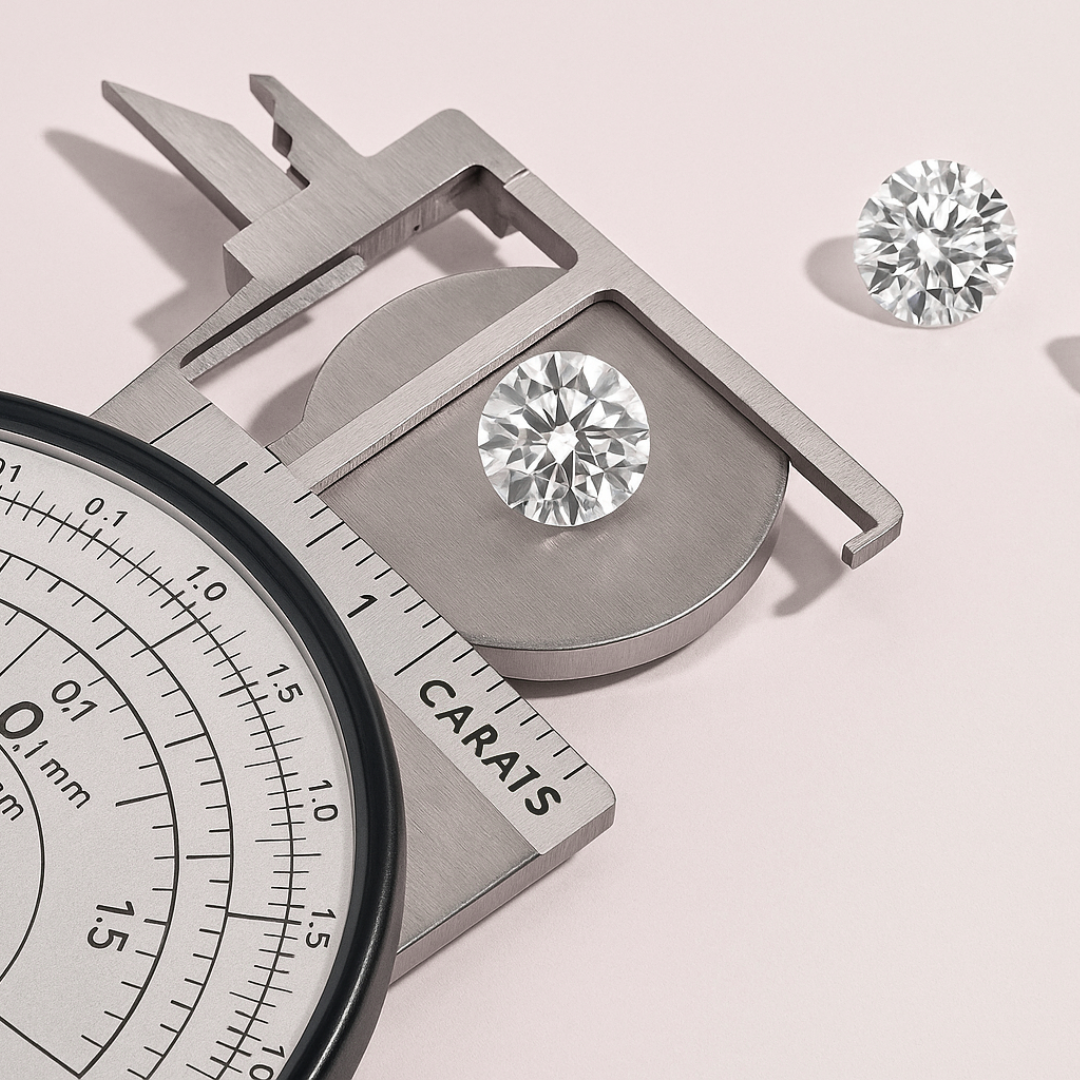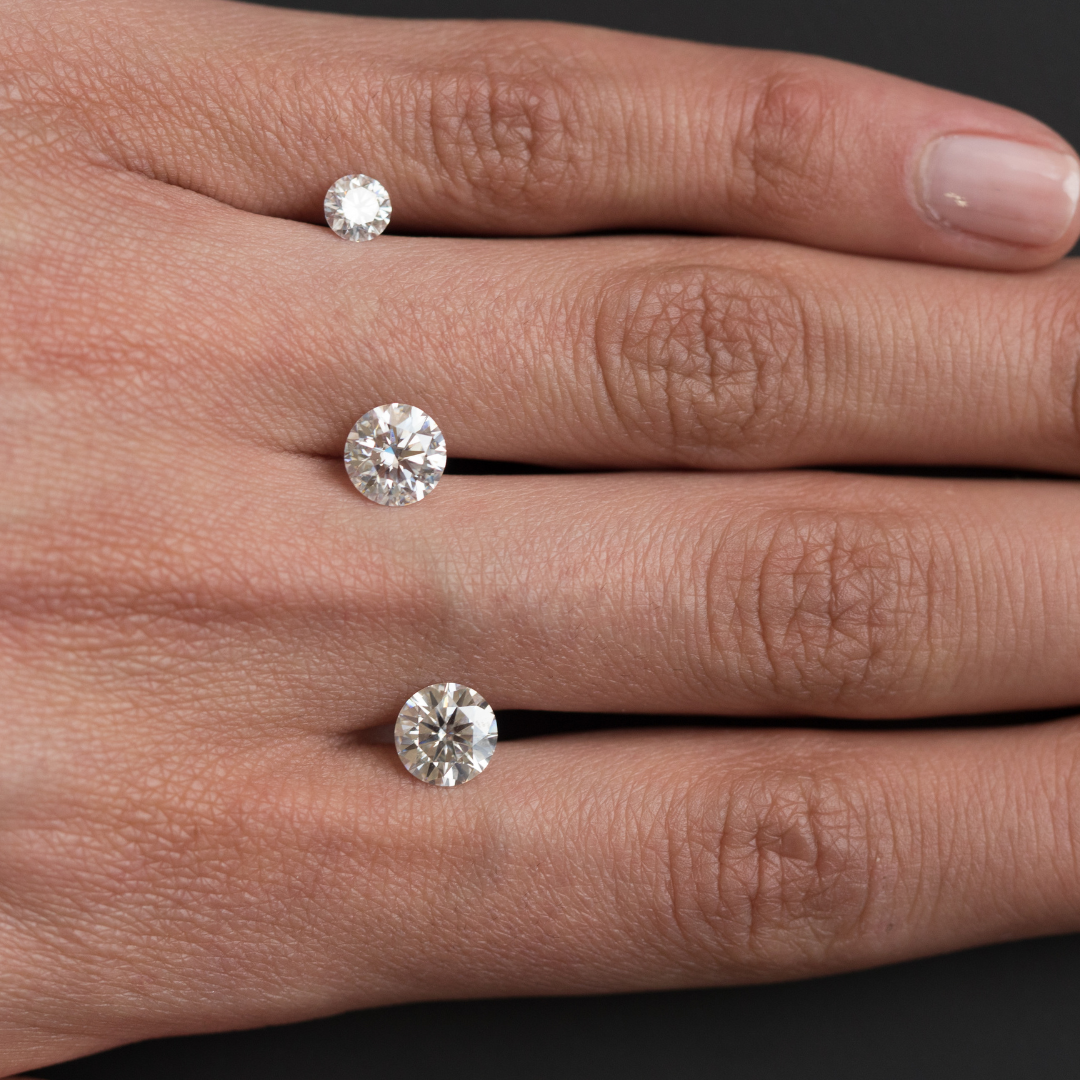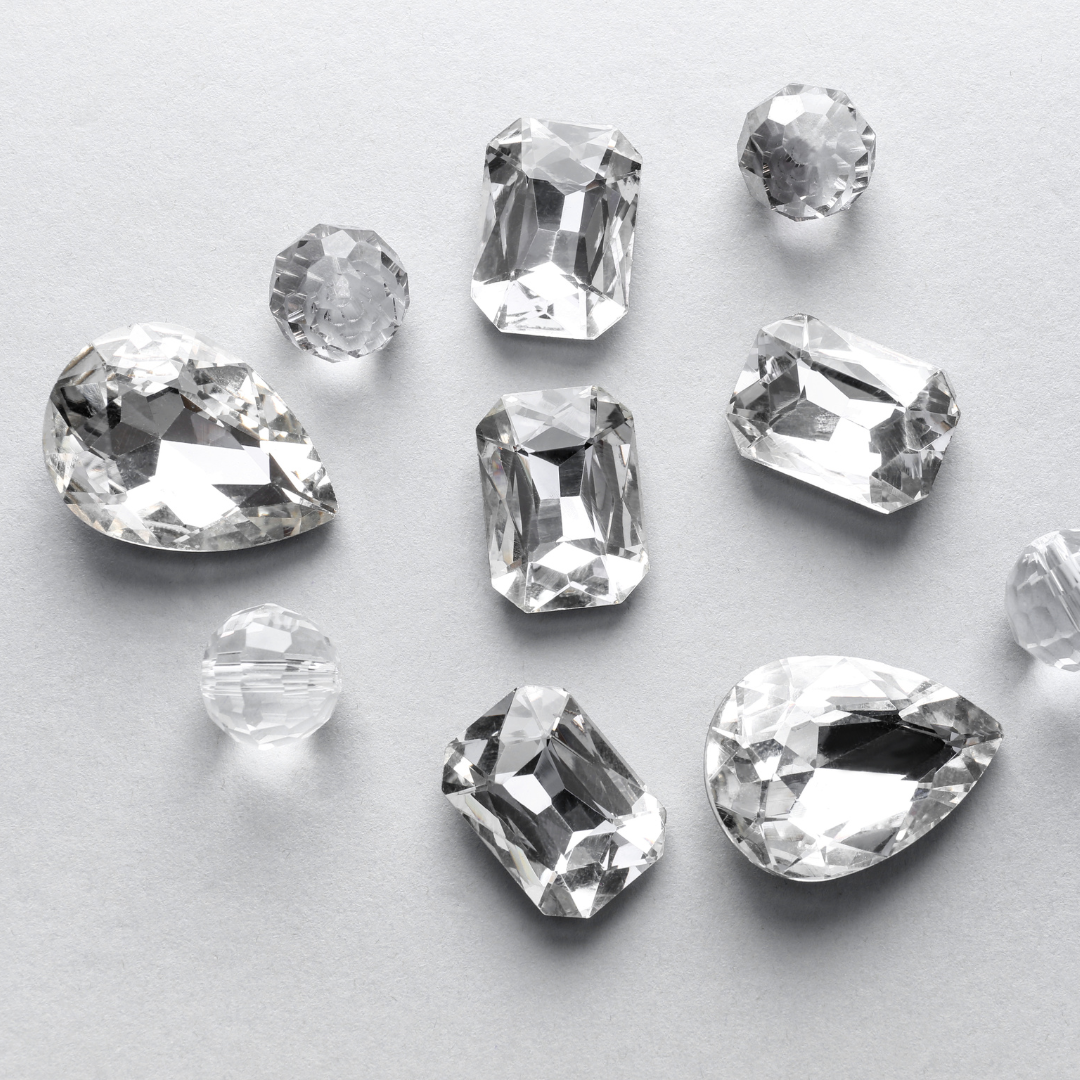IN THIS GUIDE:
- Carat vs. Millimeter: Size vs. Weight
- MM to Carat Conversion Charts
- How Many MM is 1 Carat?
- How Many Carats is 1mm?
- Factors That Affect MM-to-Carat Appearance

Carat vs. Millimeter: Size vs. Weight
Carat is a unit of weight equal to exactly 200 milligrams. It tells you how heavy a diamond is, but not necessarily how large it appears.
Millimeter (mm) measures the size of a diamond.
- For round diamonds, it measures the diameter.
- For fancy shapes, it measures the length and width.
This determines how big the diamond looks when viewed from above.
The Critical Factor: Cut Depth
Here's where it gets interesting: Two diamonds of identical carat weight can have significantly different millimeter measurements.
A deep-cut diamond carries more weight in its depth, so it appears smaller from the top. A shallow-cut diamond spreads weight across its diameter. This makes it look larger from the top, but it may lose some brilliance and fire. This is why professional jewelers always consider both carat weight and millimeter dimensions when evaluating diamonds.
MM to Carat Conversion Charts for Different Shapes
Round MM to Carat Conversion
| Diameter (mm) | Approx. Carat Weight |
|---|---|
| 4.1 mm | 0.25 ct |
| 4.8 mm | 0.40 ct |
| 5.2 mm | 0.50 ct |
| 5.8 mm | 0.75 ct |
| 6.5 mm | 1.00 ct |
| 7.4 mm | 1.50 ct |
| 8.1 mm | 2.00 ct |
| 8.7 mm | 2.50 ct |
| 9.1 mm | 3.00 ct |
Princess Cut MM to Carat Conversion
| Width (mm) | Approx. Carat Weight |
|---|---|
| 4.0 mm | 0.25 ct |
| 4.5 mm | 0.40 ct |
| 5.0 mm | 0.50 ct |
| 5.5 mm | 0.75 ct |
| 6.0 mm | 1.00 ct |
| 6.7 mm | 1.50 ct |
| 7.3 mm | 2.00 ct |
| 7.8 mm | 2.50 ct |
| 8.2 mm | 3.00 ct |
Note: Princess cuts often appear slightly smaller face-up than round diamonds of equal carat weight due to their typically deeper proportions. A 1-carat princess cut might measure approximately 6.0mm across, while a 1-carat round brilliant measures about 6.5mm in diameter.
Oval Cut MM to Carat Conversion
Ideal length-to-width ratio: 1.33–1.66
| Length × Width (mm) | Approx. Carat Weight |
|---|---|
| 5.2 × 3.5 mm | 0.25 ct |
| 6.0 × 4.0 mm | 0.40 ct |
| 6.5 × 4.3 mm | 0.50 ct |
| 7.2 × 4.8 mm | 0.75 ct |
| 8.0 × 5.3 mm | 1.00 ct |
| 9.0 × 6.0 mm | 1.50 ct |
| 10.0 × 6.6 mm | 2.00 ct |
| 10.7 × 7.1 mm | 2.50 ct |
| 11.4 × 7.6 mm | 3.00 ct |
Call-out: Oval's elongated shape makes a 1-carat diamond (approximately 8.0 × 5.3 mm) appear larger than a round brilliant of equal weight. This makes oval cuts an excellent value choice for maximizing visual impact.
Emerald Cut MM to Carat Conversion
| Length × Width (mm) | Approx. Carat Weight |
|---|---|
| 4.6 × 3.4 mm | 0.25 ct |
| 5.5 × 3.9 mm | 0.40 ct |
| 6.0 × 4.3 mm | 0.50 ct |
| 6.7 × 4.8 mm | 0.75 ct |
| 7.5 × 5.5 mm | 1.00 ct |
| 8.5 × 6.2 mm | 1.50 ct |
| 9.0 × 6.6 mm | 2.00 ct |
| 9.5 × 7.0 mm | 2.50 ct |
| 10.0 × 7.4 mm | 3.00 ct |
Radiant Cut MM to Carat Conversion
| Length × Width (mm) | Approx. Carat Weight |
|---|---|
| 4.3 × 3.8 mm | 0.25 ct |
| 5.0 × 4.4 mm | 0.40 ct |
| 5.5 × 4.8 mm | 0.50 ct |
| 6.2 × 5.4 mm | 0.75 ct |
| 6.8 × 6.0 mm | 1.00 ct |
| 7.6 × 6.7 mm | 1.50 ct |
| 8.2 × 7.2 mm | 2.00 ct |
| 8.7 × 7.6 mm | 2.50 ct |
| 9.1 × 8.0 mm | 3.00 ct |
Cushion Cut MM to Carat Conversion
| Length × Width (mm) | Approx. Carat Weight |
|---|---|
| 4.3 × 4.0 mm | 0.25 ct |
| 5.0 × 4.6 mm | 0.40 ct |
| 5.5 × 5.0 mm | 0.50 ct |
| 6.2 × 5.7 mm | 0.75 ct |
| 6.7 × 6.2 mm | 1.00 ct |
| 7.6 × 7.0 mm | 1.50 ct |
| 8.2 × 7.6 mm | 2.00 ct |
| 8.7 × 8.0 mm | 2.50 ct |
| 9.1 × 8.4 mm | 3.00 ct |
Pear Cut MM to Carat Conversion
| Length × Width (mm) | Approx. Carat Weight |
|---|---|
| 5.0 × 3.0 mm | 0.25 ct |
| 6.0 × 3.6 mm | 0.40 ct |
| 6.5 × 4.0 mm | 0.50 ct |
| 7.4 × 4.5 mm | 0.75 ct |
| 8.0 × 5.0 mm | 1.00 ct |
| 9.0 × 5.7 mm | 1.50 ct |
| 10.0 × 6.0 mm | 2.00 ct |
| 10.7 × 6.4 mm | 2.50 ct |
| 11.3 × 6.8 mm | 3.00 ct |
Styling tip: Pear shapes tend to hide shallow depth better than other cuts, making them ideal for achieving a larger look relative to carat weight. Their elongated form also has the added benefit of making fingers appear more slender.
Marquise Cut MM to Carat Conversion
| Length × Width (mm) | Approximate Carat Weight |
|---|---|
| 6.0 × 3.0 mm | 0.25 ct |
| 7.0 × 3.5 mm | 0.40 ct |
| 8.0 × 4.0 mm | 0.50 ct |
| 9.0 × 4.5 mm | 0.75 ct |
| 10.0 × 5.0 mm | 1.00 ct |
| 12.0 × 6.0 mm | 1.50 ct |
| 12.5 × 6.5 mm | 2.00 ct |
| 13.5 × 7.0 mm | 2.50 ct |

How Many MM is 1 Carat?
A frequently asked question with a shape-dependent answer:
- Round: Approximately 6.5mm diameter
- Princess: Approximately 5.5mm × 5.5mm
- Oval: Approximately 8.0mm × 5.3mm
- Emerald: Approximately 7.5mm × 5.5mm
- Cushion: Approximately 6.7mm × 6.2mm
- Pear: Approximately 8.0mm × 5.0mm
- Marquise: Approximately 10.0mm × 5.0mm
Remember that these are averages.Actual measurements will vary based on cut proportions.

How Many Carats is 1mm?
Short answer: 1mm in diameter round brilliant diamond = ~0.004 carats (about 4 points).
The Math Behind It
Using the round brilliant formula:
Carat = (Diameter in mm ÷ 6.5)³
- 1mm → (1 ÷ 6.5)³ = 0.004 ct
- 2mm → (2 ÷ 6.5)³ = 0.03 ct (8x heavier!)
- 3mm → (3 ÷ 6.5)³ = 0.1 ct
For fast and accurate conversions, use our MM to Carat Calculator. It works for all diamond shapes and sizes.
Factors That Affect MM-to-Carat Appearance
When converting between millimeters and carats, several factors influence how large a diamond appears relative to its weight:
Depth Percentage
Depth percentage is the ratio of a diamond's depth to its average diameter, expressed as a percentage. It's a critical measurement found on GIA reports that directly impacts a diamond's face-up size.
- Ideal depth (Round brilliants: ~59-62.5%): Balances optimal light performance with face-up size
- Deep cut (>64%): Appears smaller from the top but may have excellent fire and brilliance
- Shallow cut (<58%): Appears larger face-up but may sacrifice sparkle and durability
Table Percentage
The table percentage is the ratio of the table's width to the diamond's total width. This ratio also affects how big the diamond looks.
Larger tables (>60%) can make a diamond appear bigger face-up but might reduce fire
Smaller tables (<53%) may enhance scintillation but can make the diamond appear smaller
| Excellent | Very Good | Good | |
|---|---|---|---|
| Table - % | 53% – 58% | 52% – 53% or 58% – 60% |
51% or 61% – 64% |
| Depth - % | 59% – 62.3% | 58% – 58.9% or 62.4% – 63.5% |
57.5% – 57.9% or 63.6% – 64.1% |
| Crown Angle | 34 – 34.9 | 32.1 – 33.9 or 35 – 35.9 |
30.1 – 32 or 36 – 37.9 |
| Pavilion Depth - % | 42.8% – 43.2% | 42% – 42.7% or 43.3% – 43.9% |
41% – 41.9% or 44% – 45.5% |
| Girdle | Thin to Slightly Thick | Very Thin to Slightly Thick | Very Thin to Thick |
| Culet | None | Very Small | Small |
Author - Vivian is a certified gemologist with over 10 years of experience in diamond assessment and jewelry design.
Our team regularly consults with master jewelers and metallurgists to ensure we provide the most accurate, up-to-date information on jewelry metals and trends.
Last Updated: May 2025
FAQs
For princess cuts, try this quick formula:
Carat ≈ (Length in mm)³ ÷ 83
Example: A 5mm princess cut = (5×5×5)÷83 ≈ 0.6 carats
Note: Princess cuts often face up smaller than rounds - a 1ct princess is typically 5.5mm vs a round's 6.5mm.
Here's the sweet spot for different styles:
- Solitaire pendant: 5-7mm (about 0.5-1ct) - big enough to notice, not too flashy
- Tennis necklace: 2-3mm stones (diamond confetti effect)
- Three-stone piece: 5-6mm center + 3-4mm sides = perfect balance
Remember: Your neckline and chain thickness matter too!
Two likely reasons:
- It's cut deep (like a tall ice cream scoop) - more sparkle but smaller face
It's shallow (like a pancake) - looks bigger but may leak lightThe ideal? 6.5mm at 1ct means balanced proportions.
Nope! A 1ct diamond is always 200mg - depth just changes how that weight is packed. Deep cut = more weight underneath, shallow = more spread out. It's like comparing a shot glass to a martini glass holding the same amount.
It’s tricky! Settings play optical tricks:
- Halos make centers look bigger
- Prongs can "eat up" edges
For accurate sizing, jewelers use special calipers that work around settings. When in doubt, ask for the spec sheet!
For both white and yellow gold, gentle cleaning with mild soap and warm water is best. Use a soft toothbrush for crevices, and dry thoroughly. Store pieces separately to prevent scratching, and have professional cleanings once or twice yearly.





